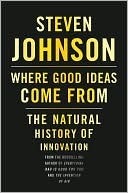More on this book
Community
Kindle Notes & Highlights
We now call this phenomenon Darwin’s Paradox: so many different life forms, occupying such a vast array of ecological niches, inhabiting waters that are otherwise remarkably nutrient-poor.
After a formidable series of measurements in his Davis lab, Kleiber discovered that this scaling phenomenon stuck to an unvarying mathematical script called “negative quarter-power scaling.” If you plotted mass versus metabolism on a logarithmic grid, the result was a perfectly straight line that led from rats and pigeons all the way up to bulls and hippopotami.
Geoffrey West decided to investigate whether Kleiber’s law applied to one of life’s largest creations: the superorganisms of human-built cities.
But the most fascinating discovery in West’s research came from the data that didn’t turn out to obey Kleiber’s law.
the quarter-power law governing innovation was positive, not negative. A city that was ten times larger than its neighbor wasn’t ten times more innovative; it was seventeen times more innovative. A metropolis fifty times bigger than a town was 130 times more innovative.
as cities get bigger, they generate ideas at a faster clip. This is what we call “superlinear scaling”:
one-to-many communications clock in at the same social innovation rate with an eerie regularity. Call it the 10/10 rule: a decade to build the new platform, and a decade for it to find a mass audience.
The graphical user interface, for instance, dates back to a famous technology demo given by pioneering computer scientist Doug Engelbart in 1968. During the 1970s, many of its core elements—like the now ubiquitous desktop metaphor—were developed by researchers at Xerox-PARC. But the first commercial product with a fully realized graphical user interface didn’t ship until 1981, in the form of the Xerox Star workstation, followed by the Macintosh in 1984, the first graphical user interface to reach a mainstream, if niche, audience. But it wasn’t until the release of Windows 3.0 in 1990—almost
...more
The long-zoom approach lets us see that openness and connectivity may, in the end, be more valuable to innovation than purely competitive mechanisms.
If there is a single maxim that runs through this book’s arguments, it is that we are often better served by connecting ideas than we are by protecting them.
The scientist Stuart Kauffman has a suggestive name for the set of all those first-order combinations: “the adjacent possible.”
What the adjacent possible tells us is that at any moment the world is capable of extraordinary change, but only certain changes can happen.
just about every essential technological advance of modern life has a multiple lurking somewhere in its origin story. In the early 1920s, two Columbia University scholars named William Ogburn and Dorothy Thomas decided to track down as many multiples as they could find, eventually publishing their survey in an influential essay with the delightful title “Are Inventions Inevitable?”
Ogburn and Thomas found 148 instances of independent innovation, most them occurring within the same decade.
Economists have a telling phrase for the kind of sharing that happens in these densely populated environments: “information spillover.” When you share a common civic culture with thousands of other people, good ideas have a tendency to flow from mind to mind,
This is not the wisdom of the crowd, but the wisdom of someone in the crowd. It’s not that the network itself is smart; it’s that the individuals get smarter because they’re connected to the network.
But the snap judgments of intuition—as powerful as they can be—are rarities in the history of world-changing ideas. Most hunches that turn into important innovations unfold over much longer time frames. They start with a vague, hard-to-describe sense that there’s an interesting solution to a problem that hasn’t yet been proposed, and they linger in the shadows of the mind, sometimes for decades, assembling new connections and gaining strength. And then one day they are transformed into something more substantial: sometimes jolted out by some newly discovered trove of information, or by another
...more
In his own account of the Web’s origins, Tim Berners-Lee makes no attempt to collapse the evolution of his marvelous idea into a single epiphany. The Web came into being as an archetypal slow hunch: from a child’s exploration of a hundred-year-old encyclopedia, to a freelancer’s idle side project designed to help him keep track of his colleagues, to a deliberate attempt to build a new information platform that could connect computers across the planet.
The Web arose as the answer to an open challenge, through the swirling together of influences, ideas, and realizations from many sides, until, by the wondrous offices of the human mind, a new concept jelled. It was a process of accretion, not the linear solving of one problem after another.
He needed a work environment that carved out a space for slow hunches, cordoned off from all the immediate dictates of the day’s agenda. And he needed information networks that let those hunches travel to other minds, where they could be augmented and polished.
The best innovation labs are always a little contaminated.
Evolutionary biologists have a word for this kind of borrowing, first proposed in an influential 1971 essay by Stephen Jay Gould and Elisabeth Vrba: exaptation. An organism develops a trait optimized for a specific use, but then the trait gets hijacked for a completely different function.
In the early 1800s, a French weaver named Joseph-Marie Jacquard developed the first punch cards to weave complex silk patterns with mechanical looms. Several decades later, Charles Babbage borrowed Jacquard’s invention to program the Analytical Engine.
Lawrence Lessig alludes to in his concept of the “hybrid economy,” which blends elements from the open networks of the intellectual commons with the more proprietary walls and tariffs of the private sphere.
The popular caricature of Darwin’s theory emphasizes competitive struggle above everything else. Yet so many of the insights his theory made possible have revealed the collaborative and connective forces at work in the natural world.


